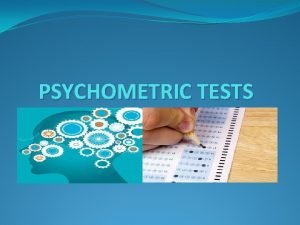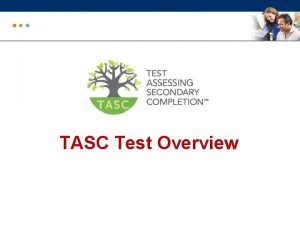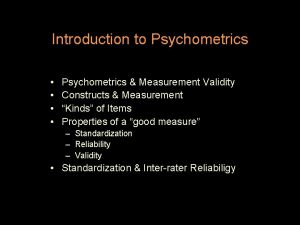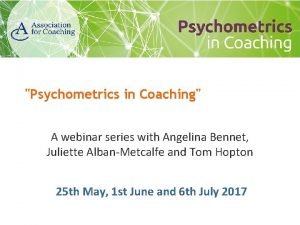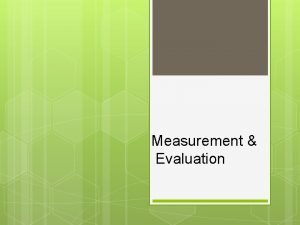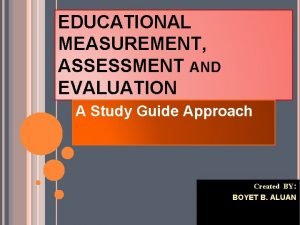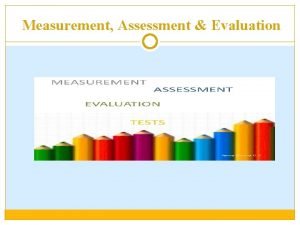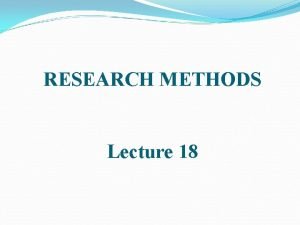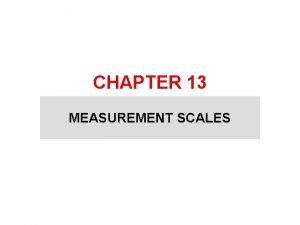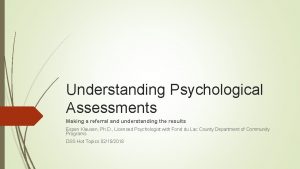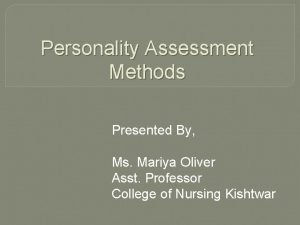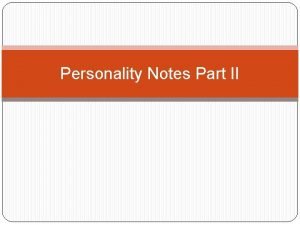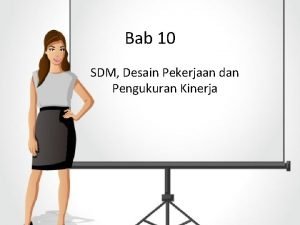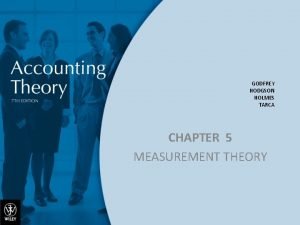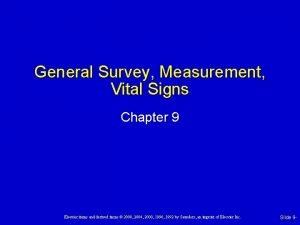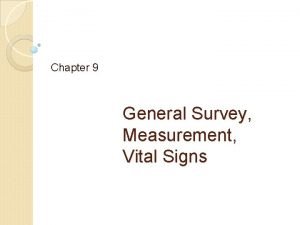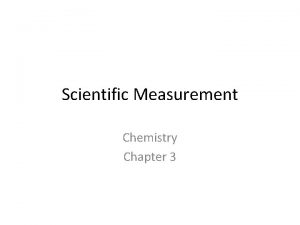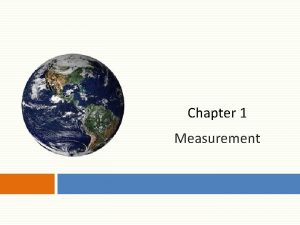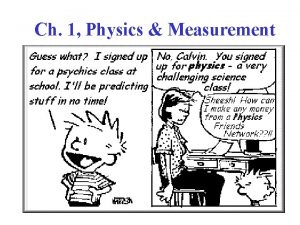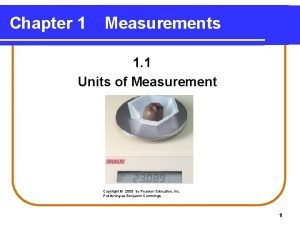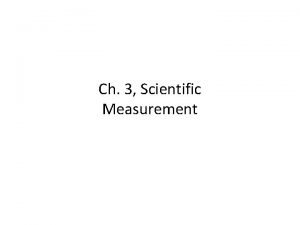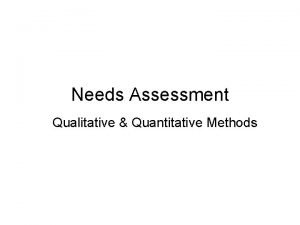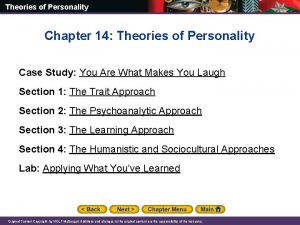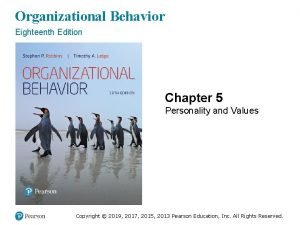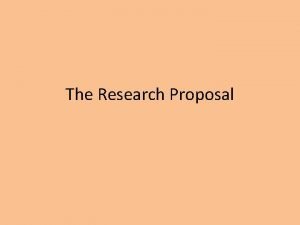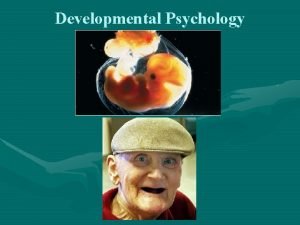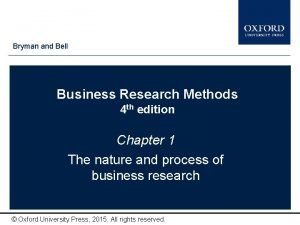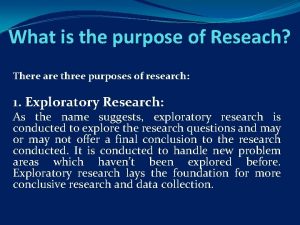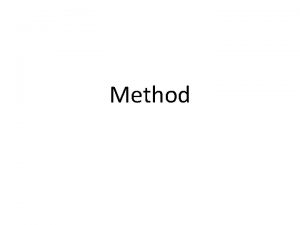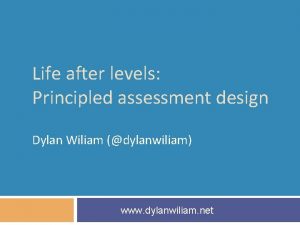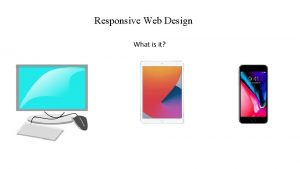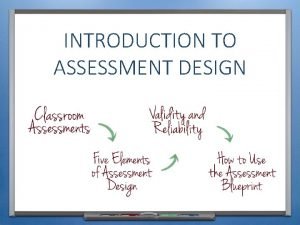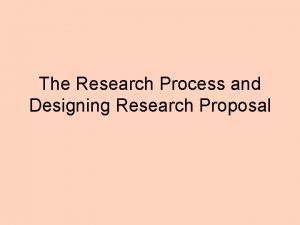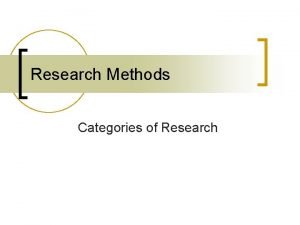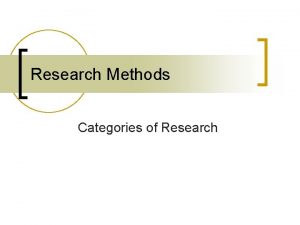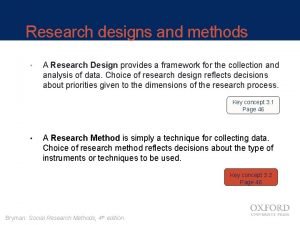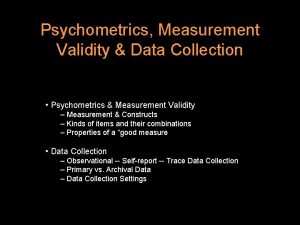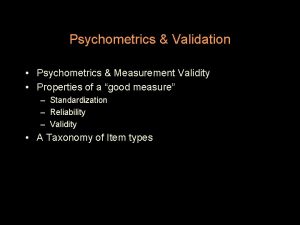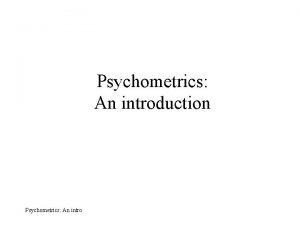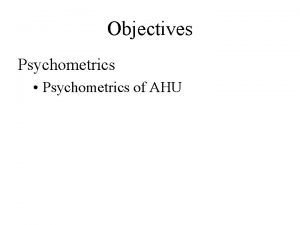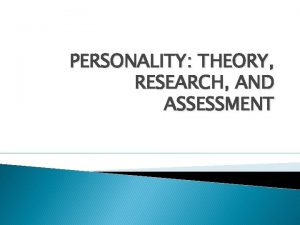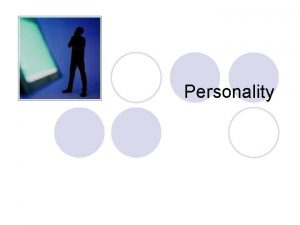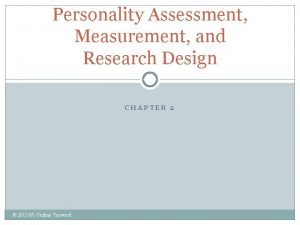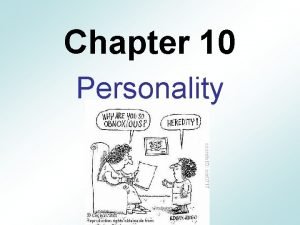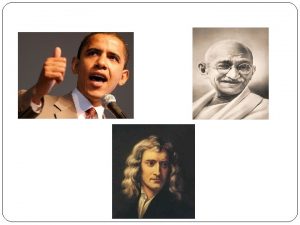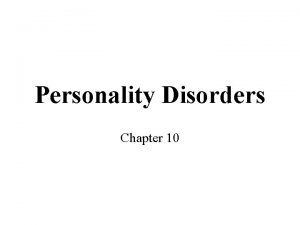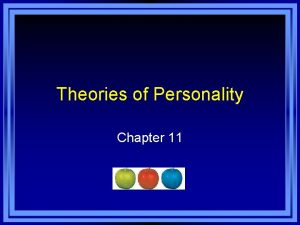Chapter 2 Personality Assessment Measurement Research Design Psychometrics



































































































- Slides: 99

Chapter 2 Personality Assessment, Measurement, & Research Design

Psychometrics & Personality ■ Individual differences psychology is closely linked to psychometrics • Correlation Coefficient • Factor analysis • Construct Validity • Test construction (1900) (1930) (1950) (1960 s)

Primary Measurement Issues 1. Where we get our information about personality, i. e. , our data sources. 2. How we evaluate our data quality. 3. How we use personality measurements in data analysis procedures to… 4. Address different research questions with different research designs.

Data Sources: LOTS of data L Life outcome data O Observer reports T Test data S Self-reports

Sources of Personality Data Self-Report The information a person reveals about her/himself in…. Questionnaires Interviews

Sources of Personality Data Self-Report • Unstructured “I am ______” EXAMPLE: “ 20 Statements. Test” I am___________ I am______

Sentence Completion Blanks Washington University Sentence Completion test of Ego -Maturity (WUSCTED) Jane Loevinger 1) At times she worried about ______ 2) The thing I like about myself is______ 3) I am_________ • Content coding procedure (requires training)

Structured tests I am devious. T F To be famous. 123456789 Types of Response formats: Check list True-False Likert

“Likert Scale” I am kindhearted. To be famous. (Likert, 1932) 1 2 3 4 5 123456789

Sources of Personality Data Self-Report Experience Sampling: - Beepers, cellphones, daily diary Mc. Clelland (1980) • Affiliation study • Compare TAT vs Questionnaire • Outcome variable = Freq of affiliating • Result: Both TAT & Ques. predicted

Sources of Personality Data Self-Report Ø Strength: Individuals have access to a wealth of information about themselves Ø Weakness: Respondents must ØImpression management ØSelf-deception be honest

Del Paulhus (UBC) Socially Desirable Responding SDR

Paulhus (1984; 2008) ■ SDR is not one thing, but two: ■ They correspond to 2 kinds of social value: agentic, communal Agentic bias • Look competent, powerful, superior Communal bias • Look kind, trustworthy, loyal

Agency and Communion

SDR IMPRESSION MANAGEMENT Agentic image Communal image SELF DECEPTION Asset Exaggeration Deviance Of Denial

Acquiescence l Yea-saying and Naysaying Agreeing regardless of content Disagreeing regardless of content l Solution: Balance wording direction l Controversial because reverse-keyed items sometimes have weaker validity than affirmative worded items.

Sources of Personality Data ■ Observer Report Data • Unique access to some data • Data aggregation across observers Cancel idiosyncratic biases Improve reliability & validity

Reiman et al. (1997) Effect of Aggregation Across Observers on Heritability Estimates

Reiman et al. (1997) Effect of Aggregation Across Observers on Heritability Estimates

Sources of Personality Data ■ Observer Report Data • Types of observers: • Professional (eg IPSR) +trained to assess reliably and validly • Intimate observers (eg roommate) +access to natural behavior +multiple vantage points (spouse, parents)

Sources of Personality Data Observer Report Data Naturalistic vs. Artificial Observation Ø Immediate vs. Retrospective Observation Ø Molar vs. Molecular Units of Observation. Ø

Sources of Personality Data Test Data Ø Participants are placed in a standardized testing situation Procedures are designed to elicit behaviour difficult to observe in everyday life. Ø

Example: Megargee (1969) • Dominance, gender & leadership • Pre-tested M and F on dominance • Groups=MM, FF, MF, FM (H/L dom) • Contrived leadership task "fix the box " task "assign your own leader". . . result: • MM: Leader was Dom (75% of time) • MF: Leader was M (80% of time) MF: Dom F chose leader! ( chose M)

Sources of Personality Data Test Data Mechanical Recording Devices Buss et al. (1980) “Actometer” study 1) Do measures converge? (ratings, actometer data) 2) Is activity-level stable over time? 3) Does actometer predict psychological functioning?

Sources of Personality Data Test Data Physiological Data…

Functional MRI

Positron Emission Tomography

Neuroscience of extraversion ■ Johnson et al. (1999) • PET • 9 low (I), 9 high (E) • resting state only ■ RESULTS • Thalamus • Insula • Broca’s Area I: ↑ Anterior, E: ↑ posterior I > E ( talking to yourself !!)

Neuroscience of spiritual feelings Borg et al. (1999)

Neuroscience of spiritual feelings Borg et al. (1999) • Measured “self-transcendence” • Measured serotonin receptor density Conclusions • Weak serotonin binding • Weak gating of sensory stimuli [? ]

Sources of Personality Data Test Data Mechanical Recording Devices Physiological Data Projective Tests

Rorshchach

Rorschach

Thematic Apperception Test (TAT) ap-perception (away from + perception) "assimilation of perception by prior knowledge" • Created 1930 s by Christiana Morgan and Henry Murray • "Tell a story" • Analyzed for motivational themes (n=need): n. Achieve, n. Power, n. Affiliation, n-Intimacy



2000


Rorschach? -No. TAT? -Yes.

Sources of Personality Data Life-Outcome Data Information that can be gleaned from the events, activities, and outcomes in a person’s life.

Motor Vehicle Accident Death rate per 10, 000

Bad-tempered Boys Outcomes ■ Caspi, Elder, Bem (1989)

Shy Boys' Outcomes ■ Caspi, Elder, Bem (1989)

Evaluating Measure Quality Reliability How trustworthy is the score? Test-Retest Reliability Split Half Reliability Alternate Forms Internal Consistency Coefficient Alpha

Why so many similar statements? ■ EPQ Extraversion Scale • 30 statements! ■ Answer: improve reliability Aggregation Reduce error variance Increase Signal/Noise ratio

Effect of aggregation on Reliability

Evaluating Data Quality Reliability = trustworthiness • Say I use Shoe Size to measure IQ… • Is it a reliable test? • Yes. Measurements of Shoe Size are very stable across time and situations. • Is it a VALID test? … Nope. Validity = meaning of scores. • Do the scores truly measure thing they are supposed to be measuring?

Types of Validity

Face Validity Face validity = Whether the item content in the measure appears to be logically relevant to the underlying concept being measured. This is not a critical form of validity for a measure, but in some circumstances can be important.

Content Validity Content validity = whether the content is fully representative of all aspects of the construct being measure. The paranormal beliefs scale above has items to cover all of the primary content distinctions that had been proposed for the concept of “paranormal belief”.

■ Convergent Validity • Proof that the scores ARE associated with things they SHOULD be associated with. ■ Discriminant Validity • Proof that the scores are NOT associated with things they should NOT be associated with. Above are correlations between paranormal beliefs and various other traits.

■ Criterion Validity • Does the measure predict something that can be considered a theoretical criterion for the concept--something it should predict if the scores were measuring what they are supposed to be measuring? This example here used “known groups” as criteria: If the paranormal beliefs measure is valid, the groups here should differ in an expected pattern: Relg. fundamentalists should be lowest and “spiritualists” should be highest in paranormal beliefs.

■ Factorial Validity • Do the items all hang together--do they intercorrelate with each other in the expected manner? In other words, do the items show good “structure”? • Example: The example on the next page shows results from a factor analysis. The numbers are correlations with two “underlying factors”. All the paranormal items correlate with the same factor, (except P 07). All the fundamentalism items correlate with the other factor. These are good results. They suggest the paranormal scale items all hang together as they should, and the fundamentalism items all hang together as they should.

Factorial Validity of a Paranormal Beliefs Scale Fac 1 Fac 2

Summary of Types of Validity

Research Designs 3 Primary Types 1) Case Study 2) Correlational 3) Experimental

Research Designs Case Studies • SINGLE PERSON + More detail, more depth + Excellent for developing theory - Bad for testing theory

Influential Case Studies • Phineus Gage (1860) • Anna O (Freud & Breuer, 1895) • HM (Henry Molaison, 1953) • Mask of Sanity (Cleckley, 1941)

Dodge Morgan


● Morgan sailed alone around the world. ● Team of trait researchers did case study of Morgan. ● Numerous personality assessments done. ● Different measurement approaches were pitted against each other. ● Whole issue of Journal of Personality (1997) devoted to Morgan.

Dodge Morgan Study by Nasby & Reid (1997) 1) 2) 3) 4) Interpersonal circumplex (Wiggins) Five factor Model Life Story narratives (Costa & Mc. Crae) (D. Mc. Adams) MMPI, Clinical Assessment (J. Butcher) Each perspective provided something unique in understanding Dodge Morgan.

Research Designs ■ Correlational: Quantify covariation between things. Correlation coefficient: r – Magnitude & direction of assoc. – (Usually) cannot infer causation from correlation.

The Correlation Coefficient: • Numerical index of covariation • Ranges from: -1. 0. . to. . +1. 0 • “. 00” = no association. Q: Which correlation below is the strongest association in the list? A) -. 59 B) +. 50 C) -. 09 D) +. 34

Guess the correlation ! r Height and Weight Extrav & Happiness Consc and GPA Consc and Creativity Aspirin and Heart attack risk Neuroticism and Happiness +. 70 +. 50 +. 30 -. 20 -. 08 -. 50

3 Common Correlational Relationships: Additive, Mediator, Moderator

Additive Self-Control r =. 45 Well-being Mindfulness r =. 30

Mindfulness Mediation (M r =. 60 ED IA Self-Control TO R ) r =. 45 r =. 00 Well-being

Moderation (interaction) Maltreatment in childhood r=. 05 r =. 42 MAO 9 0. r= Antisocial

Fundamentalist Background Spiritual Belief ? Paranormal Belief

r =. 00 M Religious Fundamentalism Low High Spirituality r =. 50 Paranormal Belief ode rato r

Multiple Correlation & Regression

Personality of Video Gamers

Causal Modeling

Factor Analysis “Seeing the forests instead of the trees” • Finding broad patterns of covariation among many variables • Partitioning covariation among many measures into independent sets • Shrinking a large number of smaller variables into a small number of larger variables.

Factor a number: 15 = 3 x 5 Factor a matrix of numbers:

Intercorrelation matrix

Intercorrelation matrix 2 product matrices

Intercorrelation matrix

e. g. , We factor analyze a correlation matrix. o Yields 2 product matrices o Eigenvalues, and eigenvectors. o Eigenvectors = “factor loadings”

Intercorrelation matrix

Intercorrelation matrix 2 product matrices

Loadings Body Mental Mass Ability Factor II I

Factor Analysis ■ Many uses 1. Discovering trait dimensions Perceptual sensitivity? Curiosity? Fantasy-proneness? Liberal Values? OPENNESS TO EXPERIENCE 2. Constructing taxonomies (e. g. , Big Five)

3. Data reduction e. g. , Aggregating predictors for regression analyses 4. Test construction e. g. , Selecting questionnaire items Factor loading

Factor Analysis 5. Evaluating the factor structure of a test “Factorial validity”

Experimental Methods ■ Typical experiment • Measure a trait • Select Hi vs. Lo on the trait • Put subjects in controlled situation • Manipulate some variable(s) • Measure some outcome(s) ■ Example…

Experimental Methods: Example Howarth & Eysenck (1988) • How does arousal influence memory? • Depends if STerm or LTerm memory: “Action Decrement theory” Example: strong emotion • Short-term memory: worsens • Long-term memory: improves

Howarth & Eysenck (1988) • High extraversion = LOW brain arousal • Low extraversion = HIGH brain arousal If true… E >I I >E short-term recall long-term recall

# Words recalled Howarth & Eysenck (1988) Ex tra ve rts Int rov ert s Delay Interval

“Significance” Need to distinguish: • Statistical significance What is the statistical probability that the result was due to random error? • Practical significance Does a result of that magnitude (r =. 09) have any real world importance?

Personality of Video Gamers

Effect Size ■ Measures of effect size 1. Magnitude of experimental effect Cohen’s d = (Group 1 – Group 2) / SD 2. Correlations are effect sizes. Can convert d to correlation.


Effect Size ■ Useful benchmarks: Large 40+ Medium 25 - 40 Small 15 - 25 ■ Example: • Milgram (1962) Obedience Study…

r =. 40

Effect Size ■ Milgram (1962) • effect size was equivalent to r =. 40 • This is one of the most well-known studies in social psychology. • Trait measures often predict important life outcomes >. 40 ■ Traits are indeed real and important.

Some Effect Sizes in Medicine: Effect sizes in personality psychology are not abysmal. A growing concern is how replicable important research findings are. Now great interest in systematic replication research in psychology.

SUMMARY • Data sources: LOTS • Data quality: Reliability and Validity • Research designs: Case study Correlational Experiment
 Introduction to psychometric
Introduction to psychometric Tasc distinguished achievement
Tasc distinguished achievement Psychometrics 101
Psychometrics 101 Introduction to psychometrics
Introduction to psychometrics Passmore psychometrics in coaching download
Passmore psychometrics in coaching download Work design and measurement
Work design and measurement Methods versus methodology
Methods versus methodology Qualitative proposal example
Qualitative proposal example Quantitative qualitative
Quantitative qualitative Characteristics of exploratory research
Characteristics of exploratory research Qualitative research design
Qualitative research design Concept map of measurement assessment and evaluation
Concept map of measurement assessment and evaluation Concept map of measurement assessment and evaluation
Concept map of measurement assessment and evaluation Definition of measurement in education
Definition of measurement in education Criteria for good measurement in research
Criteria for good measurement in research Measurement marketing research
Measurement marketing research Attitude scale
Attitude scale Types of measurement in research
Types of measurement in research Primary scales of measurement in marketing research
Primary scales of measurement in marketing research Attitude measurement in marketing research
Attitude measurement in marketing research Sample referral question for personality assessment
Sample referral question for personality assessment The barnum effect in personality assessment
The barnum effect in personality assessment Personality assessment methods
Personality assessment methods Tat personality test
Tat personality test Personality assessment definition
Personality assessment definition Assessment of personality
Assessment of personality Sumber daya manusia desain pekerjaan dan pengukuran kinerja
Sumber daya manusia desain pekerjaan dan pengukuran kinerja Work design and measurement
Work design and measurement Job design continuum
Job design continuum Chapter 3 research parts quantitative
Chapter 3 research parts quantitative Chapter 10 chapter assessment chemical reactions answers
Chapter 10 chapter assessment chemical reactions answers Chapter 11 study guide chemistry stoichiometry answer key
Chapter 11 study guide chemistry stoichiometry answer key Chapter 9 study guide chemical reactions
Chapter 9 study guide chemical reactions Chapter 9 surface water answer key
Chapter 9 surface water answer key Chapter 2 assessment physics principles and problems
Chapter 2 assessment physics principles and problems Chemistry: the central science chapter 14 answers
Chemistry: the central science chapter 14 answers Chapter 2 chapter assessment
Chapter 2 chapter assessment Properties of ionic compounds
Properties of ionic compounds 7 ionic and metallic bonding practice problems
7 ionic and metallic bonding practice problems What is documentation portfolio
What is documentation portfolio Define dynamic assessment
Define dynamic assessment Portfolio assessment matches assessment to teaching
Portfolio assessment matches assessment to teaching Measurement theory in accounting
Measurement theory in accounting Chapter 9 general survey and measurement
Chapter 9 general survey and measurement Chapter 9 general survey and measurement
Chapter 9 general survey and measurement Chapter 8 section 3 earthquakes and society answer key
Chapter 8 section 3 earthquakes and society answer key Scalar quantity unit
Scalar quantity unit 3 scientific measurement
3 scientific measurement Chapter 1 measurement
Chapter 1 measurement Physics and measurement chapter 1
Physics and measurement chapter 1 Chapter 1 measurement
Chapter 1 measurement Chapter 3 scientific measurement
Chapter 3 scientific measurement Difference between qualitative and quantitative
Difference between qualitative and quantitative Chapter 14 theories of personality
Chapter 14 theories of personality Organization fit
Organization fit Objectives of personality
Objectives of personality Chapter 2 personality self-esteem and emotions
Chapter 2 personality self-esteem and emotions Research report vs research proposal
Research report vs research proposal Example of conclusive research
Example of conclusive research Difference between applied research and basic research
Difference between applied research and basic research Example of contribution in research paper
Example of contribution in research paper Contrast applied research and basic research
Contrast applied research and basic research Objective in problem formulation means
Objective in problem formulation means Research paradigm example
Research paradigm example Operational thought
Operational thought Correlational comparative research
Correlational comparative research Examples of applied research
Examples of applied research Basic research vs applied research
Basic research vs applied research Explanatory research vs exploratory research
Explanatory research vs exploratory research Inquiry in practical research 2
Inquiry in practical research 2 Conclusive research
Conclusive research Research objectives examples
Research objectives examples Research instrument in experimental research
Research instrument in experimental research Rikkwa floral arrangement
Rikkwa floral arrangement Principled curriculum design
Principled curriculum design Responsive design final assessment
Responsive design final assessment Assessment meaning
Assessment meaning Hand tool id
Hand tool id Solomon four group design
Solomon four group design Longitudinal research design example
Longitudinal research design example Stanford prison experiment cells
Stanford prison experiment cells Preparing for research design
Preparing for research design Cross sectional research design example
Cross sectional research design example Correlational studies
Correlational studies Single subject research design examples
Single subject research design examples Project design in research
Project design in research Research design in clinical psychology
Research design in clinical psychology Type of research design
Type of research design Qualitative research objectives
Qualitative research objectives Categories of research design
Categories of research design Types of study design
Types of study design Non experimental research design
Non experimental research design Research design quantitative example
Research design quantitative example Descriptive research meaning
Descriptive research meaning Hypothesis template
Hypothesis template Meaning of
Meaning of Descriptive research design
Descriptive research design Research design methods
Research design methods Meaning of design in research
Meaning of design in research Blueprint research meaning
Blueprint research meaning
